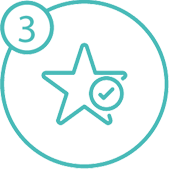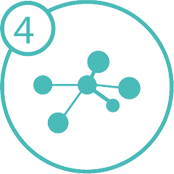Headache and Migraine
A migraine attack is a complex cerebral event that can produce many different neurological and systemic symptoms. While pain is its most distinctive characteristic, migraine can include other symptoms that occur before, during, and after pain and can become disabling for the sufferer.
Migraine is the most common cause of headache in pediatric neurology and has been acknowledged as one of the most prevailing neurological diseases in children and adolescents worldwide, affecting 5-10 % of the pediatric population in multiple life stages. The mean age for migraine onset if 7.2 years in boys and 10.9 years in girls, increasing its prevalence with age.
In adults, migraine is a primary recurrent headache disorder, with 8.6 % prevalence in males and 17.5 % in females. The World Health Organization study, Global Burden of Disease 2013, classified migraine as the sixth most common disabling disease. It has significant impact on mental and physical health because it can impair school or work performance, with a substantial reduction of quality of life, leading to social isolation. The problem worsens further when it is associated with autoimmune, gastrointestinal, and psychiatric diseases.
Many patients progress from episodic migraine to chronic migraine, which affects from 1 to 2 % of the population. It is a gradual process, in which low frequency episodic migraine shifts gradually to high frequency, and eventually, to chronic migraine.
The International Head Society (IHS) classifies them by aura presence or absence and whether it is episodic or chronic migraine.
Migraine must be diagnosed when the patient has at least 5 crises that meet the following criteria:
- Duration from 4-72 hours (untreated or with unsuccessful treatment)
At least two of the following characteristics:
- Unilateral location
- Throbbing pain of moderate to severe intensity, aggravated by usual physical activity or its abandonment
At least one of the following:
- Nausea and / or vomit
- Photophobia and / or phonophobia.
A diagnosis of chronic migraine must be given when at least 15 monthly attacks are reported that meet the migraine diagnostic criteria described above, for a minimum of 3 consecutive months. This migraine type is much more disabling functionally than episodic migraine.
As such, migraine is somewhat similar to epilepsy. Both conditions reflect brains that contain abnormally sensitive neurons. Just as with migraine, the source of this sensitivity in epilepsy can be genetic. Migraine and epilepsy are co-morbidities (that is, if a person is afflicted by migraine, it is likely for him to suffer of epilepsy, and vice versa). The fact that several of the most effective medications in migraine prevention were developed to treat epilepsy (for example, sodium valproate and topiramate) strengthens this relationship further.
Based on the above, the therapy currently available to prevent or reduce headache frequency and severity includes efficient and safe antiepileptic drugs, approved to be used in adults in Europe since 2003 and in the United States since 2004. The mechanism is considered to be associated with activity of inhibitory neurons, deemed to be deficient in migraine and that improves with these drugs.
The pathogenesis of migraine has not been fully understood yet. Some evidence shows that abnormal serotonin levels and its receptors are involved in this process, suggesting that a low serotonin level facilitates the activation of the trigeminovascular nociceptive pathway.
Some neurotransmitters and their agonists can relieve migraine, and antidepressants like the selective serotonin reuptake inhibitors have been used successfully as prophylactic treatments.
The neurotransmission or GABAergic and serotonergic enhancement achieves dramatic improvements in this disease.
The neurophysiological studies frequently show paroxysmal activity or hyperexcitability damages correlated with inhibitory neurotransmission deficiency, where the GABA and serotonin neurotransmitters play an essential role. Therefore, their neurotransmission enhancement has a significant impact on the improvement of the patient.References:
- Domínguez Salgado, M., et al. “Cefalea En La Infancia y La Adolescencia. Aportaciones Basadas En La Evidencia.” Acta Pediátrica Española, IMSALUD Madrid,
- Doulberis, Michael, et al. “Is There an Association between Migraine and Gastrointestinal Disorders?” Journal of Clinical Neurology, vol. 13, no. 3, 2017, p. 215., doi:10.3988/jcn.2017.13.3.215.
- Guía de Práctica Clínica: Diagnóstico y Tratamiento de la cefalea tensional y migraña en el adulto. Primer y segundo nivel de atención, México, Secretaría de Salud. 03/11/2016.
- “The International Classification of Headache Disorders, 3rd Edition (Beta Version).” Cephalalgia, vol. 33, no. 9, 2013, pp. 629–808., doi:10.1177/0333102413485658.
- Natoli, Jl, et al. “Global Prevalence of Chronic Migraine: A Systematic Review.” Cephalalgia, vol. 30, no. 5, 2009, pp. 599–609., doi:10.1111/j.1468-2982.2009.01941.x.
- Rothrock, J. F. (2008), What is Migraine? Headache: The Journal of Head and Face Pain, 48: 330. doi:10.1111/j.1526-4610.2007.01025.x
- Steiner TJ, Birbeck GL, Jensen RH, Katsarava Z, Stovner LJ, Martelletti P. Headache disorders are third cause of disability worldwide. J Headache Pain. 2015;16:58. doi: 10.1186/s10194-015-0544-2. [PMC free article] [PubMed] [Cross Ref]
- “The International Classification of Headache Disorders, 3rd Edition (Beta Version).”Cephalalgia, vol. 33, no. 9, 2013, pp. 629–808., doi:10.1177/0333102413485658.
- Xu, Xiao-Min, et al. “Tricyclic Antidepressants for Preventing Migraine in Adults.” Medicine, vol. 96, no. 22, 2017, doi:10.1097/md.0000000000006989.

 English
English  日本語 (Japan)
日本語 (Japan)  Español
Español 




